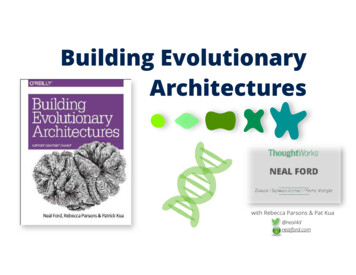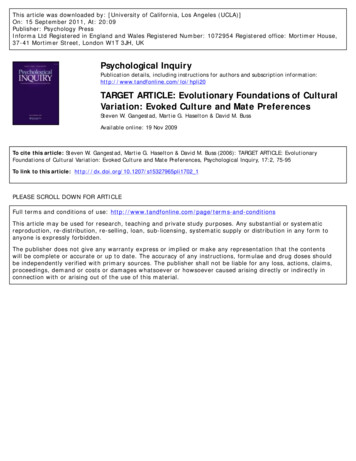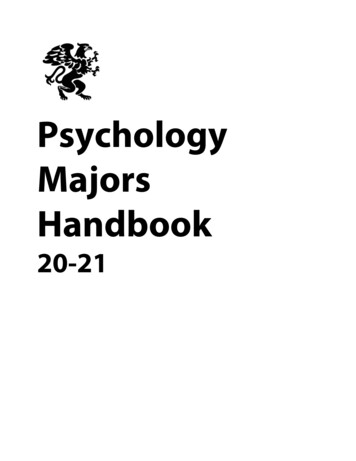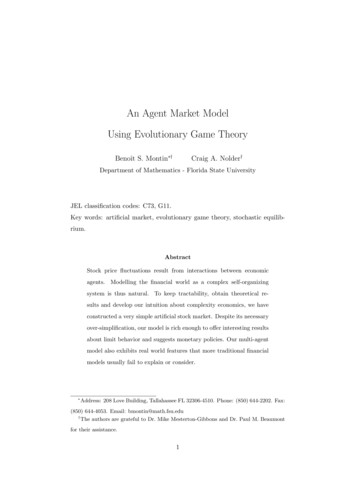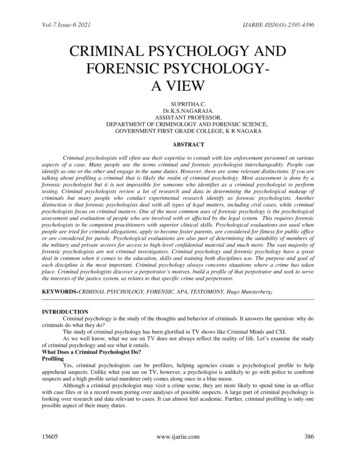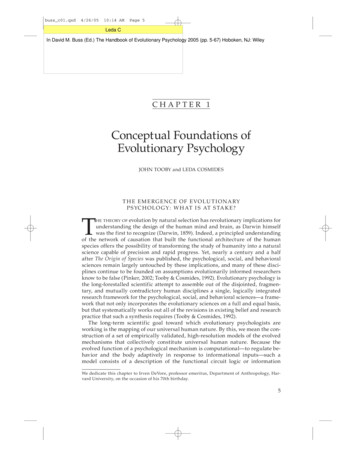
Transcription
buss c01.qxd4/26/0510:14 AMPage 5CHAPTER 1Conceptual Foundations ofEvolutionary PsychologyJOHN TOOBY and LEDA COSMIDEST H E E M E RG E N C E O F E VO L U T I O NA RYP S YC H O LO G Y : W H AT I S AT S TA K E ?THE THEORY OF evolution by natural selection has revolutionary implications forunderstanding the design of the human mind and brain, as Darwin himselfwas the first to recognize (Darwin, 1859). Indeed, a principled understandingof the network of causation that built the functional architecture of the humanspecies offers the possibility of transforming the study of humanity into a naturalscience capable of precision and rapid progress. Yet, nearly a century and a halfafter The Origin of Species was published, the psychological, social, and behavioralsciences remain largely untouched by these implications, and many of these disciplines continue to be founded on assumptions evolutionarily informed researchersknow to be false (Pinker, 2002; Tooby & Cosmides, 1992). Evolutionary psychology isthe long-forestalled scientific attempt to assemble out of the disjointed, fragmentary, and mutually contradictory human disciplines a single, logically integratedresearch framework for the psychological, social, and behavioral sciences—a framework that not only incorporates the evolutionary sciences on a full and equal basis,but that systematically works out all of the revisions in existing belief and researchpractice that such a synthesis requires (Tooby & Cosmides, 1992).The long-term scientific goal toward which evolutionary psychologists areworking is the mapping of our universal human nature. By this, we mean the construction of a set of empirically validated, high-resolution models of the evolvedmechanisms that collectively constitute universal human nature. Because theevolved function of a psychological mechanism is computational—to regulate behavior and the body adaptively in response to informational inputs—such amodel consists of a description of the functional circuit logic or informationWe dedicate this chapter to Irven DeVore, professor emeritus, Depart ment of Anthropology, Harvard University, on the occasion of his 70th birthday.5
buss c01.qxd64/26/0510:14 AMPage 6FOUNDATIONS OF EVOLUTIONARY PSYCHOLOGYprocessing architecture of a mechanism (Cosmides & Tooby, 1987; Tooby & Cosmides, 1992). Eventually, these models should include the neural, developmental,and genetic bases of these mechanisms, and encompass the designs of otherspecies as well.A genuine, detailed specification of the circuit logic of human nature is expected to become the theoretical centerpiece of a newly reconstituted set of socialsciences, because each model of an evolved psychological mechanism makes predictions about the psychological, behavioral, and social phenomena the circuitsgenerate or influence. (For example, the evolutionarily specialized mechanismsunderlying human alliance help to explain phenomena such as racism and groupdynamics; Kurzban, Tooby, & Cosmides, 2001.) A growing inventory of such models will catalyze the transformation of the social sciences from fields that are predominantly descriptive, soft, and particularistic into theoretically principledscientific disciplines with genuine predictive and explanatory power. Evolutionary psychology in the narrow sense is the scientific project of mapping ourevolved psychological mechanisms; in the broad sense, it includes the project ofreformulating and expanding the social sciences (and medical sciences) in lightof the progressive mapping of our species’ evolved architecture.The resulting changes to the social sciences are expected to be dramatic andfar-reaching because the traditional conceptual framework for the social and behavioral sciences—what we have called the Standard Social Science Model(SSSM)—was built from defective assumptions about the nature of the humanpsychological architecture (for an analysis of the SSSM, see Tooby & Cosmides,1992). The most consequential assumption is that the human psychological architecture consists predominantly of learning and reasoning mechanisms thatare general-purpose, content-independent, and equipotential (Pinker, 2002;Tooby & Cosmides, 1992). That is, the mind is blank-slate like, and lacks specialized circuits that were designed by natural selection to respond differentially toinputs by virtue of their evolved significance. This presumed psychology justifies a crucial foundational claim: Just as a blank piece of paper plays no causalrole in determining the content that is inscribed on it, the blank-slate view of themind rationalizes the belief that the evolved organization of the mind plays little causal role in generating the content of human social and mental life. Themind with its learning capacity absorbs its content and organization almost entirely from external sources. Hence, according to the standard model, the socialand cultural phenomena studied by the social sciences are autonomous and disconnected from any nontrivial causal patterning originating in our evolved psychological mechanisms. Organization flows inward to the mind, but does notflow outward (Geertz, 1973; Sahlins, 1976).Yet if—as evolutionary psychologists have been demonstrating—the blank-slateview of the mind is wrong, then the social science project of the past century is notonly wrong but radically misconceived. The blank-slate assumption removes thecentral causal organizers of social phenomena—evolved psychological mechanisms—from the analysis of social events, rendering the social sciences powerlessto understand the animating logic of the social world. Evolutionary psychologyprovokes so much reflexive opposition because the stakes for many social scientists, behavioral scientists, and humanists are so high: If evolutionary psychologyturns out to be well-founded, then the existing superstructure of the social andbehavioral sciences—the Standard Social Science Model—will have to be disman-
buss c01.qxd4/26/0510:14 AMPage 7Conceptual Foundations of Evolutionary Psychology7tled. Instead, a new social science framework will need to be assembled in itsplace that recognizes that models of psychological mechanisms are essential constituents of social theories (Boyer, 2001; Sperber, 1994, 1996; Tooby & Cosmides,1992). Within such a framework, the circuit logic of each evolved mechanism contributes to the explanation of every social or cultural phenomenon it influences orhelps to generate. For example, the nature of the social interactions between thesexes are partly rooted in the design features of evolved mechanisms for matepreference and acquisition (Buss, 1994, 2000; Daly & Wilson, 1988; Symons, 1979);the patterned incidence of violence is partly explained by our species’ psychologyof aggression, parenting, and sexuality (Daly & Wilson, 1988); the foundations oftrade can be located in evolved cognitive specializations for social exchange (Cosmides & Tooby, 1992, this volume); both incest avoidance and love for family members are rooted in evolved mechanisms for kin recognition (Lieberman, Tooby, &Cosmides, 2003, in press-a, in press-b). Indeed, even though the field is in its infancy, evolutionary psychologists have already identified a large set of examplesthat touch almost every aspect of human life (see, e.g., the chapters of this volume,as well as the chapters in Barkow, Cosmides, & Tooby, 1992).For almost a century, adherence to the Standard Social Science Model has beenstrongly moralized within the scholarly world, immunizing key aspects fromcriticism and reform (Pinker, 2002; Tooby & Cosmides, 1992). As a result, in theinternational scholarly community, criteria for belief fixation have often strayeddisturbingly far from the scientific merits of the issues involved, whenever research trajectories produce results that threaten to undermine the credibility ofthe Standard Social Science Model. Nevertheless, in recent decades, the strain ofignoring, exceptionalizing, or explaining away the growing weight of evidencecontradicting traditional theories has become severe. Equally, reexaminations ofthe arguments advanced in favor of the moral necessity of the Standard SocialScience Model suggest that they—at best—result from misplaced fears (Pinker,2002; Tooby & Cosmides, 1992). Indeed, we may all have been complicit in the perpetuation of vast tides of human suffering—suffering that might have been prevented if the scientific community had not chosen to postpone or forgo a moreveridical social and behavioral science.T H E I N T E L L E C T UA L OR I G I N S O FE VO L U T I O NA RY P S YC H O LO G YDespite the marginalization of Darwinism within psychology during the twentieth century, a diverse minority of thinkers tried to think through how Darwinian insights could be applied to behavior. These efforts led to many valuableapproaches, including: the instinct psychology of William James and WilliamMcDougall; the ethological approach of Tinbergen, Lorenz, and von Frisch,which integrated the careful observation of animal behavior in natural contextswith investigations of its adaptive significance and physiological basis; the sociobiological approach of Richard Alexander, William Hamilton, Robert Trivers,Edward O. Wilson, and many others, which tried to explain patterns of socialbehavior—differences as well as universals—in humans and other species interms of their fitness consequences; nativist approaches to language pioneeredby Chomsky (1959, 1966), Lenneberg (1967), and others, which brought to widerattention the question of whether one general-purpose learning system could
buss c01.qxd84/26/0510:14 AMPage 8FOUNDATIONS OF EVOLUTIONARY PSYCHOLOGYaccount for all learning; and even behaviorist psychology—quite orthodox withrespect to the Standard Social Science Model—looked for phylogenetic continuities in the laws of learning that would apply across species. As valuable as eachof these approaches turned out to be, conceptual handicaps internal to each program limited their scope of application and their capacity to usefully reorganizethe human psychological, behavioral, and social sciences.The way past these limitations involved isolating or deriving a core set of foundational concepts from the intersection of physics, biology, and information theory, elucidating their logical and causal interrelationships, and then buildingback upward from this groundwork. (A few representative concepts are function,regulation, computational architecture, adaptation, organization, design, entropy, selection, replication, selection pressure, by-product, environment of evolutionary adaptedness, and task environment.) These concepts could then be used to trace out thenecessary interconnections among several previously distinct scientific programs, so that the previously independent (and inconsistent) disciplinary building blocks could be integrated into a single unified framework (Tooby &Cosmides, 1992). The building blocks from which evolutionary psychology wasassembled include the modern revolution in theoretical evolutionary biology(Williams, 1966), the rise of the computational sciences (Shannon, 1948), theemergence of serious attempts to reconstruct the ancestral conditions and ways oflife of humans and prehumans (e.g., Cheney et al., 1987; Lee & DeVore, 1968,1976), and an adaptationist/computationalist resolution of the debate betweenenvironmentalists and nativists (e.g., Cosmides & Tooby, 1987; Tooby & Cosmides, 1990a, 1990b, 1992; Tooby, Cosmides, & Barrett, 2003).The first building block of evolutionary psychology was the strain of theoreticalevolutionary biology that started in the late 1950s and early 1960s, especially withthe work of George Williams (Williams, 1966; Williams & Williams, 1957); WilliamD. Hamilton (1964); and John Maynard Smith (1982). By being placed on a morerigorous, formal foundation of replicator dynamics, evolutionary biology wastransformed over the ensuing decades from a vaguely conceptualized and sometimes implicitly teleological field into a principled discipline that rivals physics inits theoretical beauty and explanatory power. One face of this transformation hasbeen the derivation of a series of elegant selectionist theories—theories of how natural selection acts on altruism, kinship, cooperation, mating, foraging, reproduction, parenting, risk taking, aggression, senescence, host-parasite interactions,intragenomic conflict, life history, communication, and many other dimensions oflife. Research in biology and the human sciences informed by these theories iscalled sociobiology, behavioral ecology, or evolutionary ecology.The other face of this revolution in biology is modern adaptationism—a set ofdeductions that are still often misunderstood, even in biology (Dawkins, 1986;Tooby & Cosmides, 1992; Tooby, Cosmides, & Barrett, 2003; Williams, 1966).Adaptationism is based on the recognition that selection is the only known natural physical process that builds highly ordered functional organization (adaptations) into the designs of species, in a world otherwise continuously assaultedby the ubiquitous entropic tendency of physical systems to become increasinglydisordered with time. Thus, although not everything is functional, whenevercomplex functional organization is found in the architectures of species, its existence and form can be traced back to a previous history of selection. Moreover,for a given selection pressure to drive an allele systematically upward until it is
buss c01.qxd4/26/0510:14 AMPage 9Conceptual Foundations of Evolutionary Psychology9incorporated into the species-typical design, the same selective cause-and-effectrelationship must recur across large areas and for many generations. Complexadaptations necessarily reflect the functional demands of the cross-generationally long-enduring structure of the organism’s ancestral world, rather thanmodern, local, transient, or individual conditions. This is why evolutionary psychology as an adaptationist field concerns the functional design of mechanismsgiven a recurrently structured ancestral world, rather than the idea that behavior is the fitness striving of individuals tailored to unique circumstances(Symons, 1992; Tooby & Cosmides, 1990a).Consequently, systems of complex, antientropic functional organization (adaptations) in organisms require explanation wherever they are found; their correctexplanation ( barring supernatural events or artificial intervention) always involves a specific history of selection in ancestral environments; and so the prediction, discovery, mapping, and understanding of the functional architecture oforganisms can be greatly facilitated by analyzing the recurrent structure of aspecies’ ancestral world, in conjunction with the selection pressures that operated ancestrally. The foundational recognition that psychological mechanisms areevolved adaptations connects evolutionary biology to psychology in the strongestpossible fashion, allowing everything we know about the study of adaptations tobe applied to the study of psychological mechanisms. Psychology and evolutionary biology can no longer be defensibly divorced.George Williams’s 1966 volume, Adaptation and Natural Selection: A Critique ofSome Current Evolutionary Thought was central to both the selectionist and adaptationist revolutions. In it, Williams provided the first fully modern statement of therelationship between selection and adaptive design; clarified that selection operates at the genic level; developed strict evidentiary standards for deciding whataspects of a species’ phenotype were adaptations, by-products of adaptations, ornoise, and usefully distinguished the present usefulness of traits from theirevolved functions (if any).1The second building block of evolutionary psychology was the rise of the computational sciences and the recognition of the true character of mental phenomena. Boole (1848) and Frege (1879) formalized logic in such a way that it becamepossible to see how logical operations could be carried out mechanically, automatically, and hence through purely physical causation, without the need for ananimate interpretive intelligence to carry out the steps. This raised the irresistible theoretical possibility that not only logic but other mental phenomenasuch as goals and learning also consisted of formal relationships embodied nonvitalistically in physical processes (Weiner, 1948). With the rise of informationtheory, the development of the first computers, and advances in neuroscience, itbecame widely understood that mental events consisted of transformations of1The arguments that not every trait is an adaptation, not all beneficial effects of a trait are its functions, that phenotypes are full of by-products, and that there are constraints on developing systemswere all central to Williams’s 1966 critique of evolutionary biology. Thus, many of us were surprised when, 13 years later, Stephen Jay Gould and Richard Lewontin (1979) began to repeat thesame critique without attribution, writing as if it were unknown to the evolutionary communitythey were criticizing. One striking difference between the two critiques was Williams’s development of strict standards of evidence to distinguish adaptations from nonadaptations, rendering theissue a matter of empirical research rather than post hoc rhetoric.
buss c01.qxd104/26/0510:14 AMPage 10FOUNDATIONS OF EVOLUTIONARY PSYCHOLOGYstructured informational relationships embodied as aspects of organized physical systems in the brain. This spreading appreciation constituted the cognitiverevolution. The mental world was no longer a mysterious, indefinable realm, butlocatable in the physical world in terms of precisely describable, highly organizedcausal relations.Evolutionary psychology can therefore be seen as the inevitable intersectionof the computationalism of the cognitive revolution with the adaptationism ofWilliams’s evolutionary biology: Because mental phenomena are the expressionof complex functional organization in biological systems, and complex organicfunctionality is the downstream consequence of natural selection, then it mustbe the case that the sciences of the mind and brain are adaptationist sciences,and psychological mechanisms are computational adaptations. In this way, themarriage of computationalism with adaptationism marks a major turning pointin the history of ideas, dissolving the intellectual tethers that had limited fundamental progress and opening the way forward. Like Dalton’s wedding ofatomic theory to chemistry, computationalism and adaptationism solve eachother’s deepest problems, and open up new continents of scientific possibility(Cosmides & Tooby, 1987; Tooby & Cosmides, 1992; Tooby, Cosmides, & Barrett,2003, 2005).Sociologically speaking, the single most significant factor in triggering the renewed efforts to apply evolution to behavior was the selectionist revolution inevolutionary biology, which subsequently became known as sociobiology (Wilson, 1975). Across the world, biologists and allied researchers were electrified bythe potential predictive and explanatory power of the new selectionist theoriesthat were emerging, together with how elegantly and systematically they couldbe derived. Dynamic research communities formed at Oxford, Cambridge, Sussex, Michigan, Harvard, the University of California, and elsewhere. As a resultof the flood of empirical and theoretical work coming out of these communities,the sociobiological revolution rapidly established itself in the biological journalsas the dominant theoretical approach biologists apply to understanding the behavior of nonhumans—a position behavioral and social scientists are surprised tofind that it occupies today.2Under the sponsorship of Irven DeVore and E. O. Wilson, one of the most influential and dynamic of these communities gathered at Harvard. This researchcommunity fluoresced in DeVore’s living room, where Harvard’s Simian Seminarwas held from the late 1960s through the mid-1980s. In this atmosphere of ongoing discovery, ideas and findings sparked each other in an endless chain reaction.A remarkable procession of figures in evolutionary biology, behavioral ecology,primatology, and ethology spoke at DeVore’s Simian Seminar, participating inthis chain reaction, and sometimes staying for protracted periods. These includedGeorge Williams, Bill Hamilton, John Maynard Smith, Ernst Mayr, Edward O.2Intellectuals wedded to the blank slate generated an unslakable demand for seemingly authoritative dismissals of the new biology. As a result, the handful of biologists who were willing to ignorethe data and supply these dismissals came to be seen as the authentic voices of scientific biology tothe intellectual world at large (e.g., Gould & Lewontin, 1979). The decisive empirical success of theparadigm within biology itself—what Alcock (2001) calls “the triumph of sociobiology”—is largelyunknown outside of the field, and the majority of nonbiologists labor under the misimpressionthat sociobiology was substantively discredited by “real” biologists.
buss c01.qxd4/26/0510:14 AMPage 11Conceptual Foundations of Evolutionary Psychology11Wilson, Richard Alexander, Richard Dawkins, Tim Clutton-Brock, Paul Harvey,Joseph Shepher, Lionel Tiger, Robin Fox, Diane Fosse, Jane Goodall, RichardWrangham, Robert Hinde, Richard Leakey, Richard Lee, Stephen Jay Gould, Martin Daly, and Margo Wilson, and the editor of this Handbook, David Buss. Amongthe participating students who became transformed into active researchers inthis environment were Bob Bailey, Peter Ellison, Steve Gaulin, Sarah Blaffer Hrdy,Melvin Konner, Jeff Kurland, Peter Rodman, Robert Sapolsky, John Seger, BarbaraSmuts, Bob Trivers, and ourselves ( John Tooby and Leda Cosmides).While Wilson’s contributions are deservedly famous through his books andpublications, DeVore’s intellectual impact is less well known because his ideaswere realized through his students and colleagues. Deeply interested in humanorigins, DeVore pioneered three major research movements. He instigated andthen championed the systematic study of primate social behavior under naturalconditions (DeVore, 1965). With Chagnon, Irons, and others, he worked on applying the new selectionist biology to anthropological questions. He inaugurated thesystematic, empirical investigation of living hunter-gatherers (Lee & DeVore,1968, 1976).DeVore and his colleague Richard Lee eschewed the “lone anthropologist”model (with its typological baggage), in which a single individual spends timedocumenting “the” culture of a people. In its place, they innovated a team-basedapproach like that found in other sciences. Their Kalahari San project broughtscientists and scholars from a broad array of disciplines—anthropologists, demographers, physicians, linguists, folklorists, psychologists, ethologists, archeologists—in an attempt to document as completely as possible the behavior and livesof the !Kung San people in Botswana’s Kalahari desert, before hunting and gathering as a way of life vanished forever from the planet. His goal in studying the Sanwas to provide a detailed database that, when triangulated with other similarlydetailed databases drawn from other hunter-gatherer groups, would allow newand powerful inferences to be made about the selection pressures that operated onhunter-gatherers to shape human design. Behavioral ecologists would be able totest optimal foraging models by matching foraging patterns to ecological conditions. Archaeologists could better interpret patterns found at ancestral sites byseeing patterns of campfires, animal remains, tool-making debris, and middenheaps produced by the social life of living hunter-gatherers. Physicians could gaininsight into diseases of civilization by comparing diets and conditions in industrialized countries to the diets and stressors produced by a way of life that moreclosely resembles the conditions in which our species evolved. Developmentalpsychologists could gain insights into the mother-infant bond and human attachment by seeing the demands placed on infants and mothers in foraging contexts.Anthropologists could learn what social conditions foster risk pooling and foodsharing; what kinds of knowledge hunter-gatherers have about animal behaviorand plant life; how they use this knowledge in foraging; and how people negotiatethe problems and opportunities of social life in a tiny community of interdependent, extended families (see, e.g., Lee & DeVore, 1976; Shostak, 1981). While commonplace now, these ideas were pathbreaking at the time. After all, if the humanmind consists primarily of a general capacity to learn, then the particulars of theancestral hunter-gatherer world and our prehuman history as Miocene apes leftno interesting imprint on our design. In contrast, if our minds are collections ofmechanisms designed to solve the adaptive problems posed by the ancestral world,
buss c01.qxd124/26/0510:14 AMPage 12FOUNDATIONS OF EVOLUTIONARY PSYCHOLOGYthen hunter-gatherer studies and primatology become indispensable sources ofknowledge about modern human nature. DeVore’s insistence on situating the operation of natural selection within the detailed contexts of hunter-gatherer andnonhuman primate life was a signal contribution to the application of the evolutionary sciences to humans.Many members of the evolutionary research communities believed that thenew selectionist theories straightforwardly applied to humans, although otherscontinued to welcome the Standard Social Science Model arguments that learninghad insulated human life from evolutionary patterning. Human behavior exhibited many patterns that offered ready selectionist interpretations (e.g., sex differences in the psychology of mating), but many other phenomena resisted easyinterpretation and seemed to lack clear nonhuman analogues (e.g., morality, thearts, language, culture). The result was a rich and contradictory pluralism of ideasabout how evolution relates to human affairs—a pluralism that is still with us.One of the most widespread approaches to emerge is what might be called fitness teleology. Teleological explanations are found in Aristotle, and arguablyconstitute an evolved mode of interpretation built into the human mind. Humans find explaining things in terms of the ends they lead to intuitive and oftensufficient (Baron-Cohen, 1995; Dennett, 1987; Leslie, 1987, 1994). Social sciencetheories have regularly depended on explicitly or implicitly teleological thinking. Economics, for example, explains choice behavior not in terms of its antecedent physical or computational causes but in terms of how the behaviorserves utility maximization. Of course, the scientific revolution originated inRenaissance mechanics, and seeks ultimately to explain everything (non-quantum mechanical) using forward physical causality—a very different explanatorysystem in which teleology is not admissible. Darwin outlined a physical process—natural selection—that produces biological outcomes that had once beenattributed to natural teleological processes (Darwin, 1859). Williams (1966)mounted a systematic critique of the myriad ways teleology had nonetheless implicitly infected evolutionary biology (where it persists in Darwinian disguises).Computationalism assimilated the other notable class of apparently teleologicalbehavior in the universe—the seeming goal directedness of living systems—tophysical causation by showing how informational structures in a regulatory system can operate in a forward causal way (Weiner, 1948). The teleological end thatseems to exist in the future as the point toward which things tend is in reality aregulatory process or representation in the organism in the present. The modernscientific claim would be that adaptationism and computationalism in combination can explain by forward physical causation all events that once would havebeen explained teleologically.Yet, the implicit or explicit substrate underlying many attempts to apply Darwinism to human behavior was a return to the sense that human behavior wasexplained by the ends it serves. For a Darwinian, it was argued, choices, practices,culture, and institutions were explained to the extent that they could be interpreted as contributing to individual (or sometimes group) reproduction: That is,the explanation for human behavior is that it naturally tends toward the end ofmaximizing reproduction in the present and future. This theory—Darwinismtransmuted into fitness teleology—parallels the economic view of individuals asselfish utility maximizers, except that Hamilton’s (1964) concept of inclusive fitness is substituted for the economists’ concept of utility. Both approaches assume
buss c01.qxd4/26/0510:14 AMPage 13Conceptual Foundations of Evolutionary Psychology13that unbounded rationality is possible and that the mind is a general-purposecomputer that can figure out, in any situation, what will maximize a given quantity over the long term (whether utility or children). Indeed, the concept of“learning” within the Standard Social Science Model itself tacitly invokes unbounded rationality, in that learning is the tendency of the general-purpose,equipotential mind to grow—by an unspecified and undiscovered computationalmeans—whatever functional information-processing abilities it needs to serve itspurposes, given time and experience in the task environment.Evolutionary psychologists depart from fitness teleologists, traditional economists ( but not neuroeconomists), and blank-slate learning theorists by arguingthat neither human engineers nor evolution can build a computational device thatexhibits these forms of unbounded rationality, because such architectures are impossible, even in principle (for arguments, see Cosmides & Tooby, 1987; Symons1989, 1992; Tooby & Cosmides, 1990a, 1992). In any case, observed human behavior dramatically and systematically departs from the soc
life. Research in biology and the human sciences informed by these theories is called sociobiology, behavioral ecology, or evolutionary ecology. Theother face of this revolution in biology is modern adaptationism—a set of deductions that are still often misunderstood, even in biology (Dawkins, 1986;
